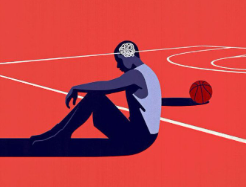Mental health in the athletic field is a topic that deserves attention and understanding. Take it from me, as both an athlete and a coach, athletic spaces are often disregarded when thinking about the importance of one’s mental health since physical health and athletic abilities are far more prominent. Athletes often are faced with immense pressure from peers, coaches, and themselves to perform at “peak” condition in their respective spaces, leaving little to no time for mental health to be considered. As athletes, we often don’t recognize a decline in our mental health until it is past the point of being fixable. This leads to a cycle of striving for greatness, feeling burnt out, and having to start back at square one. It is important to recognize that athletes, just like anyone else, can experience mental health challenges.
One of the key factors I have noticed is that the athletic field creates a constant set of expectations placed upon athletes. For example, the media often only highlights Division 1 collegiate athletes, which sets the standard for young children that in order to be the best in their respective fields, they must go Division 1 for their sport. Although this acts as a goal to strive for, this also leads to athletic burnout, as the jump from training as a middle schooler or high schooler to a collegiate athlete is vast. In the end, athletes tend to be their own worst critics.
Among college athletes, only 10% seek help for their mental health. I have seen many young athletes fall victim to feeling as though they need to constantly meet certain standards, whilst dealing with the fear of failure. This creates a significant amount of stress and anxiety for the athletes, which affects their overall mental health.
An area of sports that doesn’t get recognized nearly as much as it should is how injuries take a toll on not only an athlete’s physical health, but their mental health. Dealing with physical pain, recovery processes and the fear of re-injury can often lead to athletes feeling as though they’ve underperformed or are letting their teammates down. On top of this, there is the pressure to quickly return to their sport, which leads to a greater risk for re-injury. Speaking from experience, the acclimation back into a sport following an injury is a lengthy and uncomfortable process that can make one feel defined by their injuries. My advice to all athletes: take the recovery process slow and let yourself heal! It’s truly a long and grueling process, but it will be for the better. Taking an extra week off can be the difference between playing next season or cutting your sports career short.
All in all, it’s crucial for athletes to have access to mental health resources and various support systems in their respective fields. By creating a culture that promotes open and outright communication of mental health issues, the athletic field can quickly become a healthier atmosphere. In order to avoid falling victim to poor mental health in the athletic field, I recommend to my athletes that they set realistic goals and focus on the Athletic Rule of Thirds. This metaphorical rule states that out of all games and practices, one-third should be great, one-third should be just okay, and one-third should be bad. I’ve found this to be a solid rule of thumb to follow, and it serves as a means to self-evaluate after each practice. This is one of my favorite ways to get my athletes, and myself, to be self-forgiving after each practice. Overall, it’s important to remember that mental health is just as important as physical health. To all the athletes out there; be kind to yourself and keep striving!









